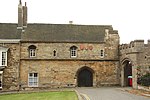The Old Bishop's Palace is a historic visitor attraction in the city of Lincoln, Lincolnshire. When it was first built, in the late 12th century, it was at the centre of the vast Diocese of Lincoln, which stretched from the Humber to the Thames. The Palace was one of the most impressive buildings of medieval England, reflecting the power and wealth of Lincoln's bishops. It is situated on a spectacular hillside site, just below Lincoln Cathedral, providing extensive views over the city. The site lies immediately to the south of the Roman wall which had become the medieval defensive wall of the Bail, which enclosed both Lincoln Castle and Lincoln Cathedral. The palace was damaged during the Civil War and subsequently largely abandoned. During the period that followed the Bishop's main residence was Buckden Palace in Huntingdonshire. In 1841, following the reduction in size of the Diocese of Lincoln, the Bishop moved to Riseholme, to the north of Lincoln. This proved inconvenient and Riseholme Hall was sold. In 1886 an older building on the western side of the Palace enclosure was substantially rebuilt and enlarged in a Tudor revival style by the architect Ewan Christian. A further change occurred in 1888 when the architects Bodley and Garner rebuilt and converted the southern portion of the medieval Great Hall into a chapel for the Bishop.In 1945 it was decided that this Palace was too large and in 1948 the Bishop's residence was moved to Atherstone Place on the north side of the cathedral. The Victorian Bishop's palace subsequently became a Diocesan Retreat centre and since 2009 has been run as the Old Palace Hotel.
The ruined parts of the Medieval Palace were placed in the guardianship of the Ministry of Works in 1954, and are now managed by English Heritage. A programme of restoration, excavation and interpretation has been carried out. A modern garden plan was laid out by Mark Anthony Walker, in 2001, and a vineyard re-established in 2012.









